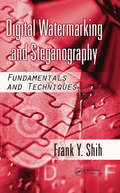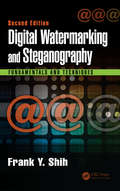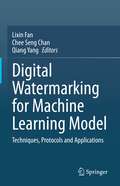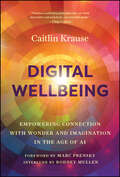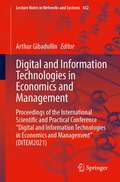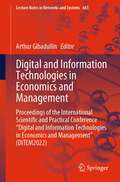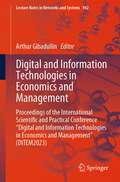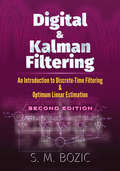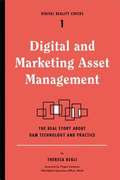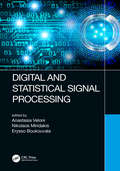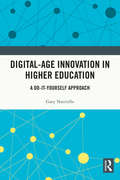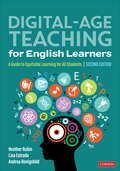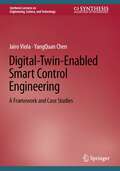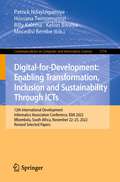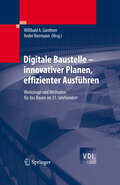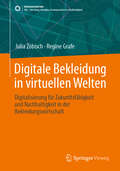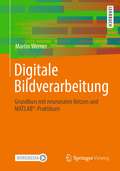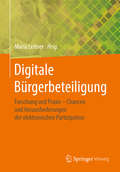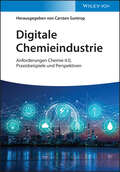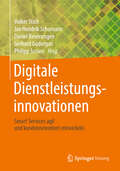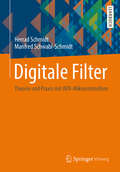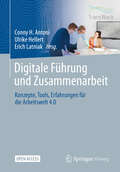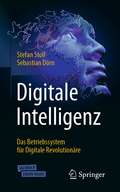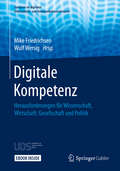- Table View
- List View
Digital Watermarking and Steganography: Fundamentals and Techniques
by Frank Y. Shih<p>Every day millions of people capture, store, transmit, and manipulate digital data. Unfortunately free access digital multimedia communication also provides virtually unprecedented opportunities to pirate copyrighted material. Providing the theoretical background needed to develop and implement advanced techniques and algorithms, Digital Watermarking and Steganography: <p> <li>Demonstrates how to develop and implement methods to guarantee the authenticity of digital media <li>Explains the categorization of digital watermarking techniques based on characteristics as well as applications <li>Presents cutting-edge techniques such as the GA-based breaking algorithm on the frequency-domain steganalytic system</li> <p>The popularity of digital media continues to soar. The theoretical foundation presented within this valuable reference will facilitate the creation on new techniques and algorithms to combat present and potential threats against information security.</p>
Digital Watermarking and Steganography: Fundamentals and Techniques, Second Edition
by Frank Y. ShihThis book intends to provide a comprehensive overview on different aspects of mechanisms and techniques for information security. It is written for students, researchers, and professionals studying in the field of multimedia security and steganography. Multimedia security and steganography is especially relevant due to the global scale of digital multimedia and the rapid growth of the Internet. Digital watermarking technology can be used to guarantee authenticity and can be applied as proof that the content has not been altered since insertion. Updated techniques and advances in watermarking are explored in this new edition. The combinational spatial and frequency domains watermarking technique provides a new concept of enlarging the embedding capacity of watermarks. The genetic algorithm (GA) based watermarking technique solves the rounding error problem and provide an efficient embedding approach. Each chapter provides the reader with a fundamental, theoretical framework, while developing the extensive advanced techniques and considering the essential principles of the digital watermarking and steganographic systems. Several robust algorithms that are presented throughout illustrate the framework and provide assistance and tools in understanding and implementing the fundamental principles.
Digital Watermarking for Machine Learning Model: Techniques, Protocols and Applications
by Chee Seng Chan Qiang Yang Lixin FanMachine learning (ML) models, especially large pretrained deep learning (DL) models, are of high economic value and must be properly protected with regard to intellectual property rights (IPR). Model watermarking methods are proposed to embed watermarks into the target model, so that, in the event it is stolen, the model’s owner can extract the pre-defined watermarks to assert ownership. Model watermarking methods adopt frequently used techniques like backdoor training, multi-task learning, decision boundary analysis etc. to generate secret conditions that constitute model watermarks or fingerprints only known to model owners. These methods have little or no effect on model performance, which makes them applicable to a wide variety of contexts. In terms of robustness, embedded watermarks must be robustly detectable against varying adversarial attacks that attempt to remove the watermarks. The efficacy of model watermarking methods is showcased in diverse applications including image classification, image generation, image captions, natural language processing and reinforcement learning. This book covers the motivations, fundamentals, techniques and protocols for protecting ML models using watermarking. Furthermore, it showcases cutting-edge work in e.g. model watermarking, signature and passport embedding and their use cases in distributed federated learning settings.
Digital Wellbeing: Empowering Connection with Wonder and Imagination in the Age of AI
by Caitlin Krause“Digital Wellbeing masterfully explores the intersection of technology and human potential. This book is a must-read for those who want to leverage the power of AI to unlock their creativity and imagination and ultimately invent new means of expression that will go way beyond human language, art, and science of today.” —Ray Kurzweil, inventor, futurist, and author of New York Times bestseller The Singularity Is Nearer Elevate your digital wellbeing by embracing wonder, creativity, and technology Digital Wellbeing is a transformative guide that offers leaders, business professionals, educators, and lifelong learners a path to thrive in the digital age. Krause provides innovative strategies to enhance mindfulness, creativity, and wellbeing in a world enriched by technology. This book empowers readers to leverage digital tools to create meaningful, positive connections and improve their overall quality of life. Discover how to integrate principles of wonder, awe, creativity, and imagination with cutting-edge technology to achieve a balanced and fulfilling digital experience. Learn about frameworks for digital wellbeing and how to apply them effectively. Gain insights on using technology to enhance connection and a sense of belonging. Explore the impact of spatial computing, immersive imagination, virtual reality, and AI on wellbeing. Understand social media's impact on societal expectations and personal interactions. Access actionable strategies for leaders, educators, and individuals to excel digitally. Learn how tech usage can be more intentional and less reactionary. Engage with reflection questions and exercises to deepen understanding and application. Combining the structure of a how-to guide with the depth of a reflective workbook, this book offers practical advice and engaging exercises, all delivered in Krause's distinctive voice. Explore the transformative potential of Digital Wellbeing and learn how to excel in a digitally connected world with wonder and imagination. Begin your journey towards a balanced, enriching digital life today.
Digital and Information Technologies in Economics and Management: Proceedings of the International Scientific and Practical Conference "Digital and Information Technologies in Economics and Management" (DITEM2021) (Lecture Notes in Networks and Systems #432)
by Arthur GibadullinThis book addresses the issues of information, digital and intellectual technologies in economics and management. The International Scientific and Practical Conference "Digital and Information Technologies in Economics and Management" (DITEM2021) was held on November 2, 2021, on the Microsoft Teams platform due to COVID-19. A distinctive feature of the book is that it presented reports of authors from Italy, South Korea, Poland, Armenia, Republic of Belarus and the Russian Federation. Researchers from different countries presented the process of transition of economic activities to the information and digital path of development and presented the main directions and developments that can improve the efficiency and development of the economy and management. The book may be useful to state and regional authorities, international and supranational organizations, the scientific and professional community.
Digital and Information Technologies in Economics and Management: Proceedings of the International Scientific and Practical Conference "Digital and Information Technologies in Economics and Management" (DITEM2022) (Lecture Notes in Networks and Systems #683)
by Arthur GibadullinThis book covers the II International Scientific and Practical Conference "Digital and Information Technologies in Economics and Management" (DITEM2022), which was held on November 21–23, 2022. The conference addressed issues of information, digital and intellectual technologies in economics and management. A distinctive feature of the conference is that it presented reports of authors from China, Saudi Arabia, Tunisia, Uzbekistan, Tajikistan, Angola, Kazakhstan, India and Russia. Researchers from different countries presented the process of transition of economic activities to the information and digital path of development and presented the main directions and developments that can improve the efficiency and development of the economy and management. The materials of the conference may be useful to state and regional authorities, international and supranational organizations, the scientific and professional community.
Digital and Information Technologies in Economics and Management: Proceedings of the International Scientific and Practical Conference "Digital and Information Technologies in Economics and Management" (DITEM2023) (Lecture Notes in Networks and Systems #942)
by Arthur GibadullinThis book covers the III International Scientific and Practical Conference "Digital and Information Technologies in Economics and Management" (DITEM2023) which was held on November 21–23, 2023. The conference addressed issues of networks and systems related to the use of information technologies in economics and management of various sectors. A distinctive feature of the conference is that it featured presentations by authors from China, Bulgaria, Uzbekistan, Oman, Kazakhstan and Russia. Researchers from different countries presented the process of transition to new information technologies of various network and system structures and sectors. The conference made it possible to develop new scientific recommendations on the use of information, computer, digital and intellectual technologies and networks in industry and fields of activity that can be useful to state and regional authorities, international and supranational organizations, the scientific and professional community.
Digital and Kalman Filtering: An Introduction to Discrete-Time Filtering and Optimum Linear Estimation, Second Edition (Dover Books on Engineering)
by S. M. BozicThis text for advanced undergraduates and graduate students provides a concise introduction to increasingly important topics in electrical engineering: digital filtering, filter design, and applications in the form of the Kalman and Wiener filters. The first half focuses on digital filtering, covering FIR and IIR filter design and other concepts. The second half addresses filtering noisy data to extract a signal, with chapters on nonrecursive (FIR Wiener) estimation, recursive (Kalman) estimation, and optimum estimation of vector signals.
Digital and Marketing Asset Management
by RegliThe digital world is transitioning from text to media: photos, audio files, video clips, animations, games, and more. Enterprises of all kinds struggle with how to manage those media assets. Digital professionals who want to master the life cycles behind creating, storing, and reusing media need the inside scoop on how digital and media asset management technology really works.
Digital and Statistical Signal Processing
by Anastasia Veloni Nikolaos Miridakis Erysso BoukouvalaNowadays, many aspects of electrical and electronic engineering are essentially applications of DSP. This is due to the focus on processing information in the form of digital signals, using certain DSP hardware designed to execute software. Fundamental topics in digital signal processing are introduced with theory, analytical tables, and applications with simulation tools. The book provides a collection of solved problems on digital signal processing and statistical signal processing. The solutions are based directly on the math-formulas given in extensive tables throughout the book, so the reader can solve practical problems on signal processing quickly and efficiently. FEATURES Explains how applications of DSP can be implemented in certain programming environments designed for real time systems, ex. biomedical signal analysis and medical image processing. Pairs theory with basic concepts and supporting analytical tables. Includes an extensive collection of solved problems throughout the text. Fosters the ability to solve practical problems on signal processing without focusing on extended theory. Covers the modeling process and addresses broader fundamental issues.
Digital-Age Innovation in Higher Education: A Do-It-Yourself Approach
by Gary NatrielloDigital-Age Innovation in Higher Education recounts the creation, development, and growth of an innovation unit within a major university. This single case study follows the development of the EdLab at the Gottesman Libraries of Teachers College, Columbia University, which was charged with developing new services and products at a time when digital technologies were markedly beginning to impact the sector. The major steps taken – recruiting staff in key skill areas, developing projects, collaborating across organizational lines, securing resources, delivering new services, and more – are covered in detail, illustrating the opportunities and challenges presented by innovation mandates in long-established organizations with stable operations and traditional academic values and practices.
Digital-Age Teaching for English Learners: A Guide to Equitable Learning for All Students
by Lisa M. Estrada Andrea Honigsfeld Heather RubinBridge the Digital Divide with Research-Informed Technology Models Since the first edition of this bestselling resource many schools are still striving to close the digital divide and bridge the opportunity gap for historically marginalized students, including English learners. And the need for technology-infused lessons specifically aligned for English learners is even more critically needed. Building from significant developments in education policy, research, and remote learning innovations, this newly revised edition offers unique ways to bridge the digital divide that disproportionally affects culturally and linguistically diverse learners. Designed to support equitable access to engaging and enriching digital-age education opportunities for English learners, this book includes Research-informed and evidence-based technology integration models and instructional strategies Sample lesson ideas, including learning targets for activating students’ prior knowledge while promoting engagement and collaboration Tips for fostering collaborative practices with colleagues Vignettes from educators incorporating technology in creative ways Targeted questions to facilitate discussions about English language development methodology Complete with supplementary tools and resources, this guide provides all of the methodology resources needed to bridge the digital divide and promote learning success for all students.
Digital-Age Teaching for English Learners: A Guide to Equitable Learning for All Students
by Lisa M. Estrada Andrea Honigsfeld Heather RubinBridge the Digital Divide with Research-Informed Technology Models Since the first edition of this bestselling resource many schools are still striving to close the digital divide and bridge the opportunity gap for historically marginalized students, including English learners. And the need for technology-infused lessons specifically aligned for English learners is even more critically needed. Building from significant developments in education policy, research, and remote learning innovations, this newly revised edition offers unique ways to bridge the digital divide that disproportionally affects culturally and linguistically diverse learners. Designed to support equitable access to engaging and enriching digital-age education opportunities for English learners, this book includes Research-informed and evidence-based technology integration models and instructional strategies Sample lesson ideas, including learning targets for activating students’ prior knowledge while promoting engagement and collaboration Tips for fostering collaborative practices with colleagues Vignettes from educators incorporating technology in creative ways Targeted questions to facilitate discussions about English language development methodology Complete with supplementary tools and resources, this guide provides all of the methodology resources needed to bridge the digital divide and promote learning success for all students.
Digital-Twin-Enabled Smart Control Engineering: A Framework and Case Studies (Synthesis Lectures on Engineering, Science, and Technology)
by YangQuan Chen Jairo ViolaThis book presents a novel design framework for the development of Digital Twin (DT) models for process- and motion-control applications. It is based on system-data acquisition using cutting-edge computing technologies, modelling of physical-system behavior through detailed simultaneous simulation of different aspects of the system, and optimal dynamic behavior-matching of the process. The design framework is enhanced with real-time data analytics to improve the performance of the DT’s behavior-matching with the real system or physical twin.The methods of creating a DT detailed in Digital-Twin-Enabled Smart Control Engineering make possible the study of a system for real-time controller tuning and fault detection. They also facilitate life-cycle analysis for multiple critical and dangerous conditions that cannot be explored in the corresponding real system or physical twin. The authors show how a DT can be exploited to enable self-optimizing capabilities in feedback control systems.The DT framework and the control-performance assessment, fault diagnosis and prognosis, remaining-useful-life analysis, and self-optimizing control abilities it allows are validated with both process- and motion-control systems and their DTs. Supporting MATLAB-based material for a case study and an expanded introduction to the basic elements of DTs can be accessed on an associated website. This book helps university researchers from many areas of engineering to develop new tools for control design and reliability and life-cycle assessment and helps practicing engineers working with robotic, manufacturing and processing, and mechatronic systems to maintain and develop the mechanical tools they use.
Digital-for-Development: 12th International Development Informatics Association Conference, IDIA 2022, Mbombela, South Africa, November 22–25, 2022, Revised Selected Papers (Communications in Computer and Information Science #1774)
by Patrick Ndayizigamiye Hossana Twinomurinzi Billy Kalema Kelvin Bwalya Mncedisi BembeThis book constitutes the refereed proceedings of the 12th International Development Informatics Association Conference, IDIA 2022, held in Mbombela, South Africa, in November 2022. The 20 revised full papers presented in this volume were carefully reviewed and selected from 61 submissions. The papers are organized in topical sections on theories and practices in digital-for-development ecosystems; emerging technologies for transformation, inclusion and sustainable development; privacy and security in digital-for-development ecosystems; human-computer interaction (HCI) for digital inclusion; artificial intelligence (AI) for good.
Digitale Baustelle- innovativer Planen, effizienter Ausführen
by Willibald Günthner André BorrmannDas Konzept der digitalen Baustelle beschreibt die Abbildung aller bei einem Bauvorhaben anfallenden Daten in einem Baustellenmodell. Es bietet die Grundlage für einen durchgängigen Datenfluss und damit für effizientere Planungs- und Ausführungsprozesse. In dem Band stellen Experten aus Wissenschaft und Industrie Methoden und Technologien zur Umsetzung vor, darunter die 3D-gestützte Planung, die Nutzung von Systemen zur zentralen Datenhaltung, die computergestützte Simulation des Bauablaufs und die Einführung moderner Logistikkonzepte.
Digitale Bekleidung in virtuellen Welten: Digitalisierung für Zukunftsfähigkeit und Nachhaltigkeit in der Bekleidungswirtschaft (SDG - Forschung, Konzepte, Lösungsansätze zur Nachhaltigkeit)
by Regine Grafe Julia ZöbischDie Nutzung von digitaler Bekleidung als Verkaufsgut bietet eine Chance für effizienzbasierte Veränderungen in der Bekleidungstechnik, da insbesondere zeit- und materialintensive Prozesse entfallen bzw. deutlich reduziert werden können. Außerdem generiert die Transformation vom physischen zum digitalen Modedesign zusätzliche Marktsegmente und kann damit gleichzeitig das wirtschaftliche Innovationspotenzial der Branche erweitern. Der Bedarf an digitaler Bekleidung wird zu neuen Innovationen auf dem Gebiet der Software-Entwicklung führen, neue technische Schnittmengen, z. B. zur Gaming-Branche, generieren und damit gleichzeitig ein neues Feld auf dem Arbeitsmarkt für Einsteiger aus der Gaming-Branche schaffen.Dieses Buch präsentiert die Trends, die es derzeit in Sachen virtueller Bekleidung und den dafür sich entwickelnden Markt gibt. Ausgehend von der konventionellen Produktentwicklung in der Bekleidungstechnik und der digitalen Unterstützung durch 2D- sowie 3D-Design-Entwicklung soll aufgezeigt werden, welche produktionstechnischen Transfermöglichkeiten sich aktuell auf dem Markt für Bekleidung abzeichnen.
Digitale Bildverarbeitung: Grundkurs mit neuronalen Netzen und MATLAB®-Praktikum
by Martin WernerDas Buch Digitale Bildverarbeitung gibt Einblicke in typische Methoden und Anwendungen. Es liefert eine solide Grundlage für die spätere fachliche Vertiefung. Dem einführenden Charakter entsprechend, steht exemplarisches, aktives Lernen an Beispielen und Übungen mit MATLAB® im Vordergrund. Wiederholungsfragen und kurze Aufgaben mit vollständigen Lösungen sowie viele Programmbeispiele mit Online-Ressourcen unterstützen den Lernerfolg. Ein PC mit MATLAB® und der Image Processing Toolbox wird vorausgesetzt.
Digitale Bürgerbeteiligung: Forschung und Praxis – Chancen und Herausforderungen der elektronischen Partizipation
by Maria LeitnerBürgerbeteiligung, d. h. die Beteiligung der Bürgerinnen und Bürger an politischen Planungsprozessen oder Entscheidungen, wird bereits in Deutschland, Österreich und der Schweiz gefördert und gelebt. In Zeiten der Digitalisierung werden immer häufiger technische Applikationen zur elektronischen Partizipation (E-Partizipation) eingesetzt. Die Nutzung von Technologien bietet Chancen und Herausforderungen gleichermaßen, so zum Beispiel in den Bereichen Sicherheit, Datenschutz und nutzerorientierte Gestaltung. Das Buch greift genau diese Themen im Bereich der E-Partizipation auf und erläutert insbesondere Gestaltungsaspekte der digitalen Bürgerbeteiligung. Es kombiniert aktuelle Forschungsergebnisse mit bestehenden Theorien der E-Partizipation und bietet eine umfassende, interdisziplinäre Analyse aus sozialwissenschaftlicher, rechtlicher und technologischer Perspektive. Schutz der Privatsphäre und Sicherheit sind dabei zentrale Aspekte des Buches, die langfristig das Vertrauen in digitale Bürgerbeteiligung fördern können.
Digitale Chemieindustrie: Anforderungen Chemie 4.0, Praxisbeispiele und Perspektiven
by Carsten SuntropDigitale Chemieindustrie Umfassend und praxisnah bietet dieses Buch alles Wissenswerte zum Thema Digitalisierung in der chemischen Industrie Die chemische Industrie befindet sich derzeit in einem Wandel und steht vor zahlreichen Herausforderungen. Die Digitalisierung spielt dabei eine große Rolle. Sie ist nicht nur der Auslöser für Veränderungen, sondern eröffnet auch neue Wege und Möglichkeiten. Ob in digitalen Geschäftsmodellen, digitalen Prozessen oder für datenbasierte Entscheidungen - die Digitalisierung durchzieht alle Bereiche in der modernen chemischen Industrie. Digitale Chemieindustrie: Anforderungen Chemie 4.0, Praxisbeispiele und Perspektiven bietet einen umfassenden Einblick in die Digitalisierung der chemischen Industrie. Nach einem Überblick über den Status Quo und die Entwicklung der digitalen Chemieindustrie werden zahlreiche Praxisbeispiele aus unterschiedlichen chemischen Unternehmen präsentiert. Abschließend werden Wege für eine erfolgreiche digitale Transformation aufgezeigt. Ob Händler, Mittelständler, Konzerne oder Chemie-/Pharma-Standorte - an dem Thema Digitalisierung kommt keiner vorbei. Geschrieben von führenden Fachleuten aus Industrie, Hochschule und Consulting - jede Sichtweise ist anders und bereichernd. Umfassende Betrachtung der Digitalisierung in der chemischen Industrie - von digitalen Technologien über digitale Geschäftsmodelle bis hin zur digitalen Transformation. Zahlreiche Fallbeispiele aus erster Hand und konkrete Lösungsansätze machen die Thematik für die Leser:innen greifbar. Digitale Chemieindustrie: Anforderungen Chemie 4.0, Praxisbeispiele und Perspektiven ist ein unverzichtbarer Leitfaden für Projektteams und Führungskräfte in der chemisch-pharmazeutischen Industrie, alle Wissenschaftler:innen an Hochschulen sowie Unternehmensberater:innen und Referent:innen, die sich mit der Planung und Umsetzung von digitalen Prozessen in der Chemieindustrie auseinandersetzen.
Digitale Dienstleistungsinnovationen: Smart Services agil und kundenorientiert entwickeln
by Volker Stich Gerhard Gudergan Daniel Beverungen Jan Hendrik Schumann Philipp JussenDieser Herausgeberband stellt Grundlagen und unternehmensspezifische Anwendungsbeispiele digitaler Dienstleistungsinnovationen vor, die in 23 Verbundforschungsprojekten der BMBF-Förderlinie “Dienstleistungsinnovation durch Digitalisierung“ entwickelt worden sind. Zunächst werden neue Methoden für die Entwicklung digitaler, datenbasierter Dienstleistungen vermittelt und anhand von Umsetzungsbeispielen veranschaulicht. Dabei wird beispielsweise der Vergleich von klassischen Methoden des Service Engineerings mit neuen agilen Vorgehensweisen gezogen. Darauf aufbauend werden Potenziale digitaler und virtualisierter Dienstleistungsprozesse aufgezeigt. Darüber hinaus wird die unternehmensinterne Transformation durch digitale Dienstleistungen untersucht, indem übergeordnete Muster der Veränderungen betrachtet und Leitlinien für die erfolgreiche Transformation ausgearbeitet werden. Schließlich werden Veränderungen im Markt durch das zunehmende Angebot von digitalen Dienstleistungen beleuchtet und strategische Erfolgsfaktoren für die Digitalisierung der Kundenschnittstelle in Dienstleistungssystemen herausgearbeitet. Der Herausgeberband vermittelt Fachexperten und Entscheidungsträgern in Unternehmen somit neuestes Methodenwissen, erfolgreiche Anwendungsbeispiele sowie einen klaren Navigationsrahmen für die Einführung und das Management innovativer, digitaler Dienstleistungen.
Digitale Filter: Theorie und Praxis mit AVR-Mikrocontrollern
by Herrad Schmidt Manfred Schwabl-SchmidtWie digitale Filter nicht nur nach Rezept, sondern eigenschöpferisch konstruiert werden können, zeigt das Buch anschaulich. Da diese Konstruktion nur mit guten Theoriekenntnissen möglich ist, wird die erforderliche Theorie unter Einsatz graphischer Methoden und mit vielen sorgfältig ausgewählten und durchgerechneten Beispielen transparent und leicht verständlich dargestellt. Zudem werden Methoden und Tricks aus der Praxis vermittelt, derer man sich bei der Realisierung digitaler Filter mit Mikrocontrollern bedienen muss, um einsatzfähige Programme zu erhalten. Der Inhalt ist in sich abgeschlossen, weitere Kenntnisse etwa über analoge Filter und weitere Hilfsmittel werden nicht benötigt.
Digitale Führung und Zusammenarbeit: Konzepte, Tools, Erfahrungen für die Arbeitswelt 4.0
by Ulrike Hellert Erich Latniak Conny H. AntoniDas vorliegende Open Access Buch umfasst Beiträge der Projekte aus dem Verbundprojekt Modelle ressourcenorientierter und effektiver Führung digitaler Projekt- und Teamarbeit (vLead) . Im Rahmen des Förderschwerpunkts „Arbeit in der digitalisierten Welt“ des Bundesministeriums für Bildung und Forschung wurden in den Projekten Entwicklungen im Transformationsprozess der Arbeitswelt analysiert, Lösungsansätze entwickelt und diese wissenschaftlich begleitet. In den Beiträgen werden Einblicke in die erarbeiteten Erkenntnisse und entwickelten Konzepte der Projekte gegeben. Hieraus lassen sich für Akteure aus Politik und Wirtschaft Handlungsempfehlungen ableiten und es ergeben sich neue Forschungsimpulse für die Wissenschaft.
Digitale Intelligenz: Das Betriebssystem für Digitale Revolutionäre
by Sebastian Dörn Stefan StollDie Digitalisierung ist da. Sie ist aber noch längst nicht überall angekommen. In unseren Unternehmen dominieren noch die Strukturen und Denkkonzepte des Industriezeitalters. Auf individueller sowie gesellschaftlicher Ebene scheinen Digitale Innovationen jenen psychologischen Zustand auszulösen, den der Zukunftsforscher Alvin Tofler in den 1970er Jahren als Zukunftsschock bezeichnete. Die Überflutung mit Neuem sowie die allgegenwärtigen Mahnungen nach schneller Anpassung führen zu Überforderung, Ängsten und Ablehnung. Deutschland steht in einem immer schärferen, globalen Wettbewerb, der zunehmend über Software, Daten, Algorithmen und Künstliche Intelligenz geführt wird. Durch den Einsatz Digitaler Technologien lösen neue Geschäftsmodelle die Logik des traditionellen Geschäfts ab. Auf dieser zweiten Welle der Digitalisierung muss die deutsche Wirtschaft eine Antwort finden. Wie können Unternehmen im Zeitalter der Digitalen Transformation das eigene Geschäft sichern und langfristig überleben? Dieses Buch vermittelt Denk- und Handlungswerkzeuge, die die aktuellen Trends der Digitalisierung mit zeitlosen Grundsätzen untermauern. Der Leser erlangt dadurch eine Digitale Intelligenz, die Orientierung im Dschungel der Digitalisierung ermöglicht.
Digitale Kompetenz: Herausforderungen für Wissenschaft, Wirtschaft, Gesellschaft und Politik (Synapsen im digitalen Informations- und Kommunikationsnetzwerk)
by Mike Friedrichsen Wulf WersigDieses Buch präsentiert Konzepte, Lösungsansätze und Visionen aus unterschiedlichen Perspektiven, um die digitale Kompetenz bei Mitarbeitern und Führungskräften zu fördern. Es gilt auf die sich verändernden und steigenden Anforderungen an die Fachkräfte und die neuen Berufsbilder, die zu einer wachsenden Flexibilisierung und Digitalisierung des Arbeitsmarktes führen, angemessen zu reagieren. Somit besteht dringender Handlungsbedarf bei der Aus- und Weiterbildung in Digitalthemen für Mitarbeiter und Führungskräfte.Die Autoren zeigen, dass durch die internationale Verflechtung im Rahmen der Globalisierung und den daraus resultierenden Wettbewerbsdruck das Vorhandensein von digitaler Kompetenz eine Kernvoraussetzung für eine zukunftsweisende Entwicklung ist. Digitale Kompetenzen versetzen Mitarbeiter von Wirtschaftsunternehmen, Behörden und Bildungseinrichtungen in die Lage, digitale Technologien anzuwenden und darüber hinaus die digitale Transformation von Geschäftsprozessen und institutionellen Abläufen mit voranzutreiben.Der Inhalt• Was bedeutet digitale Kompetenz und was wird konkret benötigt?• Worin unterscheidet sich digitale Kompetenz von dem Buzz-Word Medienkompetenz?• Welchen Stellenwert hat die digitale Kompetenz in Unternehmen, Behörden und Bildungseinrichtungen?• Welche politischen Maßnahmen sind erforderlich, um digitale Kompetenzen aufzubauen?• Welche digitalen Kompetenzen müssen durch das Bildungssystem geschaffen werden?• Welche Veränderungen im Bildungssystem sind erforderlich?• Welche Handlungsoptionen und Lösungskonzepte gibt es?
